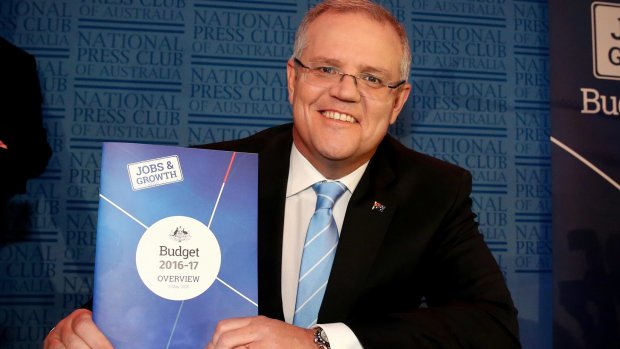Sure, there's still the usual cash splash on playgrounds and intersection upgrades, but for the first time since the GFC our major parties realise the seriousness of the budget deficit and are toning down campaign spending promises.
 When you boil them down to their essence, Australian election campaigns are really just elaborate pork barrel road shows. For all the talk about vision and ideology, politics is about what pleases marginal electorates, not philosophy.
When you boil them down to their essence, Australian election campaigns are really just elaborate pork barrel road shows. For all the talk about vision and ideology, politics is about what pleases marginal electorates, not philosophy.
Bill Shorten was in Western Australia last week doling out $45 million for Perth's Wanneroo Road. Malcolm Turnbull was there a few days later, announcing his own Wannaroo Road upgrade, but a slightly cheaper one — just $20 million.
I complained about this pattern in the 2013 election. Shorten and Turnbull are competing to head the government of a $1.6 trillion economy — Australia is one of the richest countries in the history of the world — and their job application involves dribbling out money for grade separations.
And yet there's something different about this election. It's not that the pork barreling isn't happening. Coalition and Labor candidates are dutifully travelling their electorates to announce minor environmental projects, CCTV installations and community centre upgrades. But at a national level there's a slight feeling of embarrassment about the whole charade.
Fundamentally both major political parties know that every new spending promise — every new security camera, every new fence around a local park — is a further setback to repaying the national debt.
This week Shorten announced that Labor would not promise to restore the Schoolkids Bonus, which had been scrapped by the Coalition, and refused to guarantee it would restore money to the pension that the Abbott government had cut.
These announcements constitute a dramatic reversal of years of Labor rhetoric. Both the Schoolkids Bonus and the pension changes were essential elements of the attack on the Coalition as being unfair to low and middle income earners.
Tony Abbott and Joe Hockey made the changes on the grounds that cuts had to be made to the Commonwealth budget if it was ever to return to surplus. Now finally at the end of the Coalition's first term in government Labor has conceded the point — yes, perhaps cuts, even uncomfortable, unpopular cuts, need to be made.
No doubt Shorten has known this for some time. Labor in government was unable to restore the surpluses they promised, but were nonetheless willing to reduce spending in ways that hurt them politically. Recall the cuts to single parent payments which so agonised Labor's own supporters. Shorten must feel he has a non-trivial chance of becoming prime minister, and needs to start tamping down expectations.
This is the first election since the Global Financial Crisis in which the reality of deficit politics is beginning to dawn on both major parties. Neither party has a plan to bring the budget back to surplus, but they are starting to accommodate it. It seems unlikely either side will give the sort of blanket "no cuts to health, education, the ABC, SBS" promise that Abbott did so fatefully on the eve of 2013.
Both Labor and the Coalition announced tax increases before the campaign begun. We saw in the debate on Sunday night that the Coalition is still trying to deal with the fallout from its retrospective superannuation changes. Tax increases are not ideal electoral politics, and the last thing the economy needs is a heavier tax burden. But the increases were probably necessary to give at least some patina of credibility on all the spending promises that were to be announced — at least in the absence of expenditure reduction.
Shorten says that his backtrack on the Schoolkids Bonus and pension changes came after the release of the Treasury's Pre-Election Economic and Fiscal Outlook. This is nonsensical. PEFO — one of the rituals which makes up Australian elections — did not forecast anything significantly different from the 2016 budget.
But PEFO represents Treasury's "best professional judgement" on the state of the economy, undiluted by the political needs of its masters. The Coalition in opposition is sometimes willing to second-guess Treasury. Labor is not.
PEFO made two claims that have been obvious for a while but look particularly devastating when expressed in an official Commonwealth document. First, without either tax increases or spending reductions there will be no sustained budget surplus.
Second, budget forecasts are based on an assumption that economic growth will return to its long run average. If that assumption does not hold — if, say, we go into an economic downturn — then the budget is going to be in a dire state.
The upshot of PEFO is that no side can believably maintain the traditional laissez faire approach to campaign spending promises. Sure, there's the usual money for playgrounds and intersection upgrades. But the 2016 election carnival has an unusually depressing tone. The Australian political class is learning to live with deficit politics.

 Certainly a great many of these people deserve to be in prison. But almost half the people serving prison sentences in SA were convicted of nonviolent offences.
Certainly a great many of these people deserve to be in prison. But almost half the people serving prison sentences in SA were convicted of nonviolent offences. Sixty-five per cent of former prisoners are still without a job six months after release, and one in five lack stable housing, according to a 2014 study by Melbourne University researchers. This is against a backdrop of low education levels, low proficiency in literacy and numeracy, patchy work histories, and relatively high drug and alcohol use.
Sixty-five per cent of former prisoners are still without a job six months after release, and one in five lack stable housing, according to a 2014 study by Melbourne University researchers. This is against a backdrop of low education levels, low proficiency in literacy and numeracy, patchy work histories, and relatively high drug and alcohol use. It is turning out to be a very peculiar election. Last week the Greens wholeheartedly embraced the notion of personal choice — and in the realm of corporate law no less.
It is turning out to be a very peculiar election. Last week the Greens wholeheartedly embraced the notion of personal choice — and in the realm of corporate law no less. Casual observers might be confused why what appears to be a technical legal debate — what counts as retrospectivity for the purposes of superannuation policy — has been
Casual observers might be confused why what appears to be a technical legal debate — what counts as retrospectivity for the purposes of superannuation policy — has been  The journalists at Fairfax blame current management, describing CEO Greg Hywood as being "
The journalists at Fairfax blame current management, describing CEO Greg Hywood as being " Is it impolite, at the very start of the election campaign, to talk about the budget deficit? Impolitic? It's certainly unfashionable.
Is it impolite, at the very start of the election campaign, to talk about the budget deficit? Impolitic? It's certainly unfashionable. The hyperbolic detractors have gone as far to label the scheme exploitive "
The hyperbolic detractors have gone as far to label the scheme exploitive " A budget that increases government taxing and spending, does nothing about the deficit, and enshrines a permanently bigger role for government in the economy has almost universally been described in terms such as "modest", "cautious", and "prudent". Maybe Greece's budgets were also once called "modest".
A budget that increases government taxing and spending, does nothing about the deficit, and enshrines a permanently bigger role for government in the economy has almost universally been described in terms such as "modest", "cautious", and "prudent". Maybe Greece's budgets were also once called "modest". Take the recent events at one of Australia's top universities. Outrage spread across the
Take the recent events at one of Australia's top universities. Outrage spread across the  The first time the Government rejected a Chinese bid for the S Kidman & Co. estate — Australia's largest private landholding — it was because part of the property, Anna Creek, was next to a sensitive defence site.
The first time the Government rejected a Chinese bid for the S Kidman & Co. estate — Australia's largest private landholding — it was because part of the property, Anna Creek, was next to a sensitive defence site.